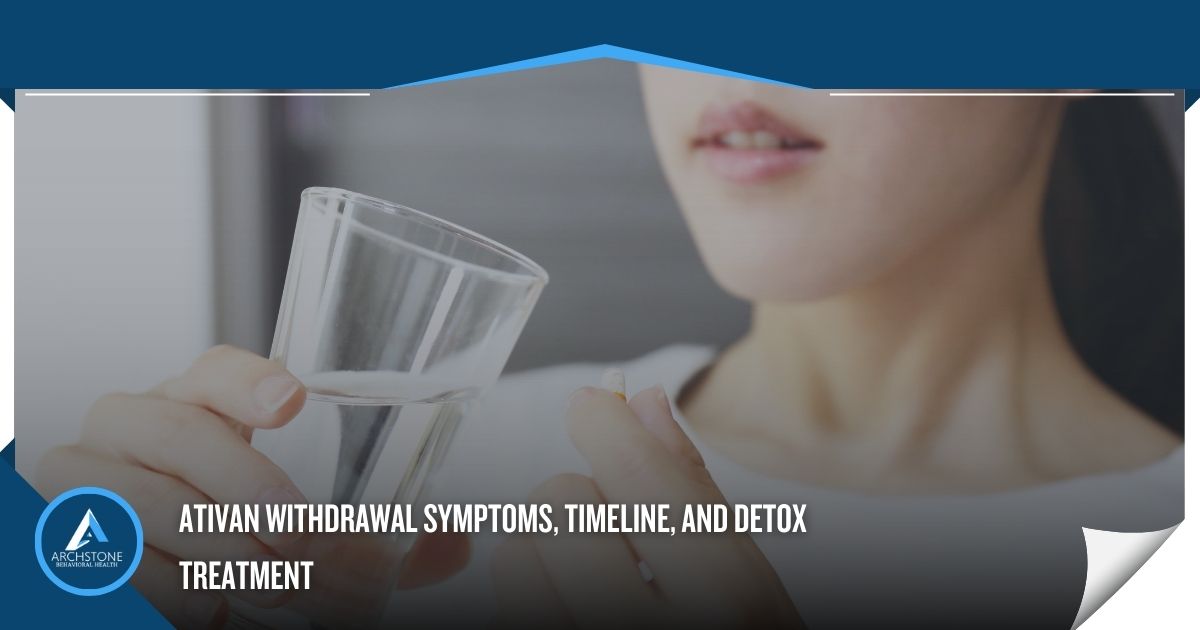Ativan Withdrawal Symptoms, Timeline, and Detox Treatment
Get Help Now
Ativan (lorazepam) is a prescription benzodiazepine used to treat anxiety disorders, panic attacks, insomnia, seizures, and even alcohol withdrawal. While this medication has valuable medical uses, it is also known to be habit-forming and addictive. When abused, Ativan can cause feelings of euphoria, dizziness, and relaxation.
Benzodiazepine addiction increases your risk of experiencing an overdose. According to the National Institute on Drug Abuse (NIDA), benzodiazepines like Ativan were responsible for 12,499 overdose deaths in 2021.[1]
If you suffer from Ativan addiction, professional treatment is necessary. Once you stop taking Ativan, you will experience withdrawal symptoms. These symptoms can be life-threatening without medical detox services.
In this article, you will learn:
- What the symptoms of lorazepam withdrawal are
- How long Ativan withdrawal lasts
- How a medical detox center can help with the withdrawal process
- Where to find a licensed benzodiazepine detox program
Understanding Ativan Withdrawal Symptoms
Benzodiazepine withdrawal can be incredibly dangerous without medical support. If you had a severe addiction to Ativan, you could experience seizures upon stopping its use. For this reason, you should always seek help from a licensed detox center.
The common symptoms of Ativan withdrawal include:[2]
- Insomnia or nightmares
- Irritability and increased tension
- Anxiety and panic attacks
- Tremors or excessive shaking
- Sweating
- Trouble concentrating
- Nausea and vomiting
- Decreased appetite and weight loss
- Heart palpitations
- Changes in blood pressure
- Headaches
- Muscle aches and pain
- Psychosis
- Seizures
If you take higher doses of Ativan, your addiction might become more severe. This puts you at an increased risk of developing serious symptoms of withdrawal when you get sober. Instead of attempting to detox at home, let medical professionals care for you within a detox facility.
The Ativan Withdrawal Timeline
Ativan is a short-acting benzodiazepine with a long duration of action.[3] As a result, it might take longer for withdrawal symptoms to arise than if you were abusing a benzodiazepine like Xanax. That being said, Ativan withdrawal symptoms usually begin within 24 hours of your last dose.
While the length of Ativan withdrawal can vary from person to person, you will most likely follow this general timeline:
24 Hours
24 hours after your last dose of Ativan, you might begin to experience mild symptoms of withdrawal. The earliest symptoms of lorazepam withdrawal include headaches, restlessness, sleep disturbances, cravings for Ativan, and nausea.
1 to 4 Days
Between 1 to 4 days after your last dose, your withdrawal symptoms will peak. This means they will be at their most severe, making it vital that you are receiving care from an addiction treatment center. If you are going to develop serious symptoms like seizures or psychosis, this is when the first signs would arise.
10 Days to 2 Weeks
Around the 10th day of withdrawal, your symptoms should begin tapering off. By two weeks, you should not be experiencing any more withdrawal symptoms. However, it is possible to develop a condition known as post-acute withdrawal syndrome (PAWS).[4]
PAWS causes prolonged symptoms of withdrawal. Typically, these symptoms are psychological rather than physical. PAWS can last for several months after acute withdrawal has been completed.
Thankfully, medical detox centers can help you overcome conditions like PAWS with medical monitoring, behavioral therapies, and medications.
How Does Detox for Ativan Withdrawal Work?
During detox, you will live at the facility full-time, and medical professionals will be able to monitor your symptoms and condition consistently. If any issues arise, you will receive prompt medical treatment to ensure an emergency does not occur.
When it comes to treating Ativan withdrawal, doctors usually slowly taper you off of the medication. This means the dose of Ativan will be reduced over time, making you less likely to experience severe withdrawal symptoms.
Other medications might be used to treat specific withdrawal symptoms, such as:
- Antidepressants for anxiety, depression, and sleep issues
- Antihistamines for anxiety or insomnia
- Anxiolytics to treat anxiety or panic attacks
- Pain relievers like ibuprofen for muscle aches and pains
Once you have overcome your physical dependence on Ativan, you will work with your doctor and therapist to create a treatment plan. Detox is only the first step in addiction recovery, so programs like inpatient rehab and outpatient treatment might be recommended. These programs will help you uncover the root causes of your addiction and develop important skills that allow you to prevent relapses in the future.
Get Connected to a Reputable Ativan Detox Center
If you or a loved one suffers from Ativan addiction, it’s time to seek professional help. Medical detox programs will help you overcome the physical aspects of addiction, keeping you safe and stable throughout the entire process.
If you are interested in Ativan detox, you’ve come to the right place. At Archstone Behavioral Health, we believe in using a combination of evidence-based treatments and compassionate care to help clients overcome withdrawal symptoms efficiently and comfortably.
Contact us today for more information on Ativan detox.
References:
- The National Institute on Drug Abuse (NIDA): Drug Overdose Death Rates
- The National Library of Medicine (NLM): The benzodiazepine withdrawal syndrome
- The Drug Enforcement Administration (DEA): Benzodiazepines
- The National Library of Medicine (NLM): Post-acute Withdrawal Syndrome
